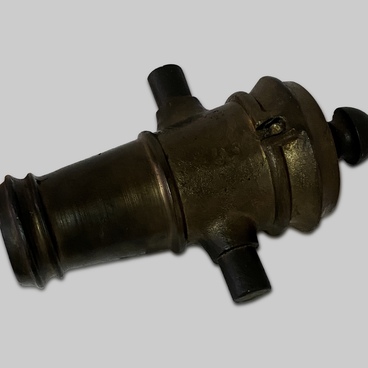The flintlock dating back to early XIX century and found in Sosnovka village of Krapivinsky district, Kemerovo region, was a true French flintlock. What remained of the flintlock are the lock spring, the tumbler and some other elements, but the trigger and the frizzen were lost.
Certain sources call such locks French, or French-style locks as the French artist and gunsmith Marin de Bourgeois from the Norman city of Lisieux, was deemed to have invented it. The inventor combined the advantages of the Mediterranean and Baltic locks in one.
The flintlock cock was located on the outside face of the lock plate while the main spring – on the inside one. The mainspring impacted the cock through a special element called tumbler. On one side of the tumbler there was a ledge for the tail side of the mainspring, on the other side there were notches to provide half-cock and full-cock. The trigger was released with a trigger sear.
In earlier designs of the flint locks the sear was located horizontally. Later a new internal vertical sear was introduced to engage the tumbler, making the process easier. The tumbler inserts fixed both the tumbler and the releasing lever inside the lock. It was attached to the lock plate with the screws.
With the passing of time, a battery was borrowed from later flintlock developments – a unit combining the flashpan cover and the frizzen. That simplified the design significantly and improved its reliability. In such lock the pan cover had its own V-shaped spring on the outside face of the lock plate.
The flintlock has certain disadvantages. A strong strike of the trigger against the battery shook the firearms and deteriorated the accuracy of fire. The ignition reliability depended on correct fixing of the frizzen in the hammer jaws and flint grinding. The result of vertical sear use was light trigger and that made the firearms insufficiently safe.
Apart from that the flintlock guns had the disadvantages typical for any other muzzle-loading arms: wind and atmospheric precipitation impact on the priming powder, potential burning by the ignited priming powder and by the powder gases coming through the touchhole. However the simplicity and reliability of the flintlock design allowed using it in the army, civil and hunting guns for over several centuries.
Certain sources call such locks French, or French-style locks as the French artist and gunsmith Marin de Bourgeois from the Norman city of Lisieux, was deemed to have invented it. The inventor combined the advantages of the Mediterranean and Baltic locks in one.
The flintlock cock was located on the outside face of the lock plate while the main spring – on the inside one. The mainspring impacted the cock through a special element called tumbler. On one side of the tumbler there was a ledge for the tail side of the mainspring, on the other side there were notches to provide half-cock and full-cock. The trigger was released with a trigger sear.
In earlier designs of the flint locks the sear was located horizontally. Later a new internal vertical sear was introduced to engage the tumbler, making the process easier. The tumbler inserts fixed both the tumbler and the releasing lever inside the lock. It was attached to the lock plate with the screws.
With the passing of time, a battery was borrowed from later flintlock developments – a unit combining the flashpan cover and the frizzen. That simplified the design significantly and improved its reliability. In such lock the pan cover had its own V-shaped spring on the outside face of the lock plate.
The flintlock has certain disadvantages. A strong strike of the trigger against the battery shook the firearms and deteriorated the accuracy of fire. The ignition reliability depended on correct fixing of the frizzen in the hammer jaws and flint grinding. The result of vertical sear use was light trigger and that made the firearms insufficiently safe.
Apart from that the flintlock guns had the disadvantages typical for any other muzzle-loading arms: wind and atmospheric precipitation impact on the priming powder, potential burning by the ignited priming powder and by the powder gases coming through the touchhole. However the simplicity and reliability of the flintlock design allowed using it in the army, civil and hunting guns for over several centuries.


